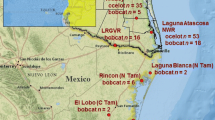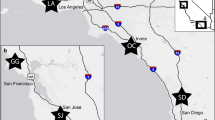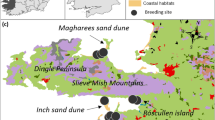Abstract
Sharp-tailed grouse (Tympanuchus phasianellus) are an area-sensitive species that relies on open landscapes of grass and brush. These areas have become highly fragmented in the Great Lakes Region by succession to forest, agriculture, and other human land uses. We used microsatellites in a landscape-genetic approach to identify landscape features that influence movement and connectivity for sharp-tailed grouse in Minnesota, where they have a regional stronghold. Feathers from leks and hunter wing submissions resulted in 367 individuals from the northwest (NW) and 84 from the east-central (EC) management regions. Both the NW and EC regions were genetically diverse and distinct, with high connectivity between them, although it is unclear whether this connection is contemporary or historical. Our analysis indicated that sharp-tailed grouse were structured across regions by land cover or by the amount of agriculture, grasslands, shrublands, and wet meadows on the larger landscape. Numerous long distance dispersal events were detected. Population clustering analysis indicated greatest support for two genetic clusters in the NW and three clusters in the EC region; however, mapping sample locations of individuals by assigned cluster revealed panmixia of clusters in the EC region. High genetic diversity, a low inbreeding coefficient, and significant excess in heterozygosity are consistent with a recent demographic compression or bottleneck in the EC region, and also consistent with surveys indicating a recent decline there. Sustained low population size or further declines would be expected to reduce genetic diversity. We recommend increasing grassland and shrubland quantity and quality to increase population size in the EC region soon.







Similar content being viewed by others
References
Ammann GA (1957) The prairie grouse of Michigan. Michigan Department of Conservation Technical Bulletin, Lansing, MI
Amos W, Balmford A (2001) When does conservation genetics matter? Heredity 87:257–265
Anderson JR, Hardy CL, Roach JT, Witmer RE (1976) A land use land cover classification system for use with remote sensor data. US Geological Survey, US Department of the Interior, US Government Printing Office, Washington, DC
Anderson MJ, Ellingsen KE, McArdle BH (2006) Multivariate dispersion as a measure of beta diversity. Ecol Lett 9:683–693
Balkenhol N, Waits LP, Raymond DJ (2009) Statistical approaches in landscape genetics: an evaluation of methods for linking landscape and genetic data. Ecography 32:818–830
Balloux F, Lugon-Moulin N (2002) The estimation of population differentiation with microsatellite markers. Mol Ecol 11(2):155–165
Berg WE (1997) The sharp-tailed grouse in Minnesota. Minnesota Wildlife Report 10, Department of Natural Resources, St. Paul, Minnesota
Berkman LK, Nielsen CK, Roy CL, Heist EJ (2013a) Population genetic structure among bobwhite in an agriculturally modified landscape. J Wildl Manag 77:1472–1481
Berkman LK, Nielsen CK, Roy CL, Heist EJ (2013b) Resistance is futile: effects of landscape genetic features on gene flow of the northern bobwhite. Conserv Genet 14:323–332
Bihrle C (1993) Upland game identification—a basic guide for aging and sexing the bird in your hand. North Dakota Outdoors 56(3):9–23
Bijlsma R, Bundgaard J, Boerema AC (2000) Does inbreeding affect the extinction risk of small populations?: predictions from Drosophila. J Evol Biol 13(3):502–514
Braunisch V, Segelbacher G, Hirzel AH (2010) Modeling functional landscape connectivity from genetic population structure: a new spatially explicit approach. Mol Ecol 19:3664–3678
Caizergues A, Dubois S, Mondor G, Loiseau A, Ellison LN, Raspluss JY (2001) Isolation and characterization of microsatellite loci in black grouse (Tetrao tetrix). Mol Ecol Notes 1:36–38
Center for International Earth Science Information Network - CIESIN - Columbia University (2005) Last of the Wild Project, Version 2, 2005 (LWP-2): Global Human Footprint Dataset (Geographic). Palisades, New York: NASA Socioeconomic Data and Applications Center (SEDAC). Global Human Footprint Dataset. Accessed 16 Dec 2015, Wildlife Conservation Society
Cheng HH, Levin I, Vallejo RL, Khatib H, Dodgson JB, Crittenden LB, Hille J (1995) Development of a genetic map of the chicken with markers of high utility. J Poultry Sci 74:1855–1874
Christopher J, Witecha M (2017) Wisconsin sharp-tailed grouse survey. http://dnr.wi.gov/topic/WildlifeHabitat/documents/reports/stgstatus2.pdf. Accessed 26 Oct 2017
Connelly JW, Gratson MW, Reese KP (1998) Sharp-tailed Grouse (Tympanuchus phasianellus). In: Rodewald PG (ed) The birds of North America. Cornell Lab of Ornithology, Ithaca, NY
Cornuet JM, Luikart G (1997) Description and power analysis of two tests for detecting recent population bottlenecks from allele frequency data. Genetics 144:2001–2014
Coulon A, Cosson JF, Angibault JM, Cargnelutti B, Galan M, Morellet N, Petit E, Aulagnier S, Hewison AJM (2004) Landscape connectivity influences gene flow in a roe deer population inhabiting a fragmented landscape: an individual-based approach. Mol Ecol 13:2841–2850
Cristescu R, Sherwin WB, Handaysde K, Cahill V, Cooper DW (2010) Detecting bottlenecks using BOTTLENECK 1.2.02 in wild populations: the importance or microsatellite structure. Conserv Genet 11:1043–1049
Cushman SA, McKelvey KS, Hayden J, Schwartz MS (2006) Gene flow in complex landscapes: Testing multiple hypotheses with causal modeling. Am Nat 168:486–499
Dent EA, vonHoldt BM (2012) STRUCTURE HARVESTER: a website and program for visualizing STRUCTURE output and implementing the Evanno method. Conserv Genet Resourc 4:359–361
Epps CW, Wehausen JD, Bleich VC, Torres SG, Brashares JS (2007) Optimizing dispersal and corridor models using landscape genetics. J Appl Ecol 44:714–724
Evanno G, Regnaut S, Goudet J (2005) Detecting the number of clusters of individuals using the software STRUCTURE: a simulation study. Mol Ecol 14:2611–2620
Fandel SG, Hull S (2011) Wisconsin sharp-tailed grouse: a comprehensive management and conservation strategy. Wisconsin Department of Natural Resources 68 Pp. https://dnr.wi.gov/files/pdf/pubs/wm/WM0622.pdf Accessed 8 Oct 2018
Faubet P, Gaggiottie OE (2008) A new Bayesian method to identify the environmental factors that influence recent migration. Genetics 178(3):1491–1504
Frankham R, Ballou JD, Briscoe DA (2002) Introduction to conservation genetics. Cambridge University Press, New York
Franklin J (2009) Mapping species distributions: spatial inference and prediction. Cambridge University Press, Cambridge, MA, pp 320
Getis A, Ord JK (1992) The analysis of spatial association by use of distance statistics. Geogr Anal 24(3):189–206
Grange WB (1948) Wisconsin grouse problems. Wisconsin Department of Conservation, Madison, WI
Gratson MW (1988) Spatial patterns, movements, and cover selection by Sharp-tailed grouse. In: Bergerud AT, Gratson MW (eds) Adaptive strategies and population ecology of northern grouse. University of Minnesota Press, Minneapolis, MN, p 158–192
Gregory AJ (2011) Landscape genetics and behavioral ecology of Greater Prairie-Chickens (Tympanuchus cupido). PhD. Dissertation, Division of Biology, Kansas State University, Manhattan, Kansas
Guillot G, Santos F, Estoup A (2008) Analyzing georeferenced population genetics data with Geneland: a new algorithm to deal with null alleles and a friendly geographical user interface. Bioinformatics 0:1–2
Hamerstrom FN, Hamerstrom F (1949) Daily and seasonal movements of Wisconsin prairie-chickens. Auk 66:313–337
Hartl DL, Clark AG (2007) Principles of population genetics. Ecoscience 14:544–545
Hess BD, Dunn PO, Whittingham LA (2012) Females choose multiple mates in the lekking Greater Prairie-chicken (Tympanuchus cupido). Auk 129:133–139
Homer C, Dewitz J, Yang L, Jin S, Danielson P, Xian G, Coulston J, Herold N, Wickman J, Megown K (2015) Completion of the 2011 National Land Cover Database for the conterminous United States-Representing a decade of land cover change information. Photogramm Eng Remote Sens 81:345–354
Johnson JA, Schroeder MA, Robb LA (2011) Greater prairie-chicken (Tympanuchus cupido). In: Poole A (ed) The birds of North America, vol 36. The Cornell Lab of Ornithology, Ithaca, New York
Krobinger GD (1980) Habitat use by nesting and brooding sharp-tailed grouse in southwestern North Dakota. North Dakota Outdoors 43:2–6
Legendre P, Gallagher ED (2001) Ecologically meaningful transformations for ordination of species data. Oecologia 129:271–280
Legendre P, Legendre L (2012) Numerical ecology, 3rd edn. Elsevier, New York, NY
Loiselle BA, Howell CA, Graham CH, Goerck JM, Brooks T, Smith KG, Williams PH (2003) Avoiding pitfalls of using species distribution models in conservation planning. Conserv Biol 17:1591–1600
Luikart G, Cornuet JM (1998) Empirical evaluation of a test for identifying recently bottlenecked populations from allele frequency data. Conserv Biol 12:228–237
Luikart G, Allendorf FW, Cornuet JM, Sherwin WB (1998a) Distortion of allele frequency distributions provides a test for recent population bottlenecks. J Heredity 89:238–247
Luikart G, Allendorf FW, Cornuet JM, Sherwin WB (1998b) Distortion of allele frequency distributions provides a test for recent population bottlenecks. Am Genet Assoc 89:238–247
Lynch M, Conery J, Burger R (1995) Mutation accumulation and the extinction of small populations. Am Nat 146:489–518
Madsen T, Stille B, Shine R (1996) Inbreeding depression in an isolated population of adders Vipera berus. Biol Conserv 75:113–118
Maples TE, Soulliere GJ (1996) Status of Michigan Sharp-tailed grouse in the 1990’s. Michigan Department of Natural Resources, Wildlife Division Report No. 3256
McRae BH (2006) Isolation by resistance. Evolution 60:1551–1561
McRae BH, Dickson BG, Keitt TH, Shah VB (2008) Using circuit theory to model connectivity in ecology, evolution, and conservation. Ecol 89:2712–2724
Mills LS, Allendrof FW (1996) The one-migrant-per-generation rule in conservation and management. Conserv Biol 10:1509–1518
Oksanen J (1983) Ordination of boreal heath-like vegetation with principal component analysis, correspondence analysis and multidimensional scaling. Vegetatio 52:181–189
Oksanen JF, Guillaume B, Friendly M, Kindt R, Legendre P, McGlinn D, Minchin PR, O’Hara RB, Simpson GL, Solymos P, Stevens MH, Szoecs E, Maintainer HW (2017) vegan: community ecology package for R. CRAN 2017-04-06 12:27:23
Oosterhout CV, Hutchinson WF, Wills DPM, Shipley P (2004) MICRO-CHECKER: software for identifying and correcting genotyping errors in microsatellite data. Mol Ecol Resources 4:535–538
Paetkau D (2003) An empirical evaluation of data quality in DNA-based population inventories. Mol Ecol 12:1375–1387
Paetkau D, Shields GF, Strobeck C (1998) Gene flow between insular, coastal and interior populations of brown bears in Alaska. Mol Ecol 7:1283–1292
Peakal R, Smouse PE (2012) GenAlEx 6.5: genetic analysis in Excel. Population genetic software for teaching and research-an update. Bioinformatics 28:2537–2539
Piertney SB, Dallas JF (1997) Isolation and characterization of hypervariable microsatellites in the red grouse (Lagopus lagopus scoticus). Mol Ecol 6:93–95
Piertney SB, Höglund J (2001) Polymorphic microsatellite DNA markers in black grouse (Tetrao tetrix). Mol Ecol Notes 1:303–304
Pritchard JK, Stephans M, Donnelly P (2000) Inference of population structure using multi-locus genotype data. Genetics 155:945–959
Prose BL (1987) Habitat suitability models: plains sharp-tailed grouse. US Fish and Wildlife Service Biological Report 82. National Ecology Center, Washington DC
Raymond M, Rousset F (1995) GENEPOP (Version 1.2): population genetics software for exact tests and ecumenicism. J Heredity 86:248–249
Rippin AB, Boag DA (1974) Spatial organization among male sharp-tailed grouse on arenas. Can J Zool 52:591–597
Robel RJ, Henderson FR, Jackson W (1972) Some sharp-tailed grouse population statistics from South Dakota. J Wildl Manag 36:87–98
Roy C (2017) 2017 Minnesota spring grouse surveys. Grouse Hunting Reports and Surveys. http://files.dnr.state.mn.us/recreation/hunting/grouse/grouse_survey_report17.pdf Accessed 27 Oct 2017
Spear SF, Balkenhol N, Fortin MJ, McRae BDH, Scribner K (2010) Use of resistance surfaces for landscape genetics studies: consideration for parameterization and analysis. Mol Ecol 19:3576–3591
Storfer A, Murphy MA, Evans JS, Goldberg CS, Robinson S, Spear SF, Dezzani R, Delmelle E, Vierling L, Waits LP (2007) Putting the ‘landscape’ in landscape genetics. Heredity 98:128–142
Taylor SE, Oyler-McCance SJ, Quinn TW (2003) Isolation and characterization of microsatellite loci in greater sage-grouse (Centrocercus urophasianus). Mol Ecol Notes 3:262–264
Waples RS (2007) LDNE: a program for estimating effective population size from data on linkage disequilibrium. Mol Ecol Notes 7:167–184
Waples RS, Peel LD, Macbeth GM, Tillett BJ, Ovenden JR (2014) NeEstimator v2: re-implementation of software for the estimation of contemporary effective population size (Ne) from genetic data. Mol Ecol Resources 14:209–214
Weir BS, Cockerham CC (1984) Estimating F-statistics for the analysis of population structure. Evolution 38:1358–1370
Wildlife Conservation Society - WCS, and Center for International Earth Science Information Network - CIESIN - Columbia University (2005) Last of the Wild Project, Version 2 (LWP-2): Global Human Footprint Dataset (Geographic). Palisades, New York: NASA Socioeconomic Data and Applications Center (SEDAC). Wildlife Conservation Society: Global Human Footprint Dataset. Accessed 16 Dec 2015
Wright S (1943) Isolation by resistance. Genetics 28:114–138
Acknowledgements
We would like to thank MNDNR staff and volunteers at Aitkin, Baudette, Bemidji, Cambridge, Cloquet, Crookston, Karlstad, International Falls, Tower, Thief River Falls, and Thief Lake work areas, staff and volunteers at Red Lake and Roseau River Wildlife Management Areas, and partners at Agassiz National Wildlife Refuge for participating in sharp-tailed grouse surveys and feather collection efforts. Eric Nelson assisted with collection of wings. Clarinda Wilson and Sophia Crosby also assisted with sharp-tailed grouse surveys and feather collection in 2015. Chris Scharenbroich helped prepare GPS units with imagery for field use. Wildlife Genetics International Lab completed genetic analyses. We would like to thank the hunters that submitted wings for this study. This project was funded in part by the Wildlife Restoration (Pittman-Robertson) Program Grant W-71-R-4. Two anonymous reviewers provided comments that greatly improved this manuscript.
Author information
Authors and Affiliations
Corresponding author
Electronic supplementary material
Below is the link to the electronic supplementary material.
Rights and permissions
About this article
Cite this article
Roy, C.L., Gregory, A.J. Landscape and population genetics reveal long distance sharp-tailed grouse (Tympanuchus phasianellus) movements and a recent bottleneck in Minnesota. Conserv Genet 20, 259–273 (2019). https://doi.org/10.1007/s10592-018-1128-x
Received:
Accepted:
Published:
Issue Date:
DOI: https://doi.org/10.1007/s10592-018-1128-x




